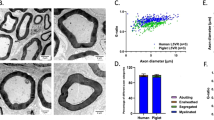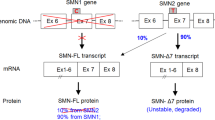Abstract
One of the major challenges in the treatment of primary muscle disorders, which often affect many muscle groups, is achieving efficient, widespread transgene expression in muscle. In utero gene transfer can potentially address this problem by accomplishing the gene delivery when the tissue mass is small and the immune system is immature. Earlier studies with systemic in utero adeno-associated viral (AAV) vector serotype 1 gene delivery to embryonic day 16 (E-16) pups resulted in high levels of transduction in diaphragm and intercostal muscles, but no detectable transgene expression in limb muscles. Recently, newer AAV serotypes, such as AAV8, have shown widespread and high transgene expression in skeletal muscles and diaphragm by systemic delivery in adult and neonatal mice. We tested AAV8 vector gene delivery by intraperitoneal administration in E-16 mice in utero. Using an AAV8 vector carrying a lacZ reporter gene, we observed high-level transduction of diaphragm and intercostal muscles and more moderate transduction of multiple limb muscles and heart. Our current studies show the potential of AAV8 to achieve widespread muscle transduction in utero and suggest its therapeutic potential for primary muscle disorders.
This is a preview of subscription content, access via your institution
Access options
Subscribe to this journal
Receive 12 print issues and online access
$259.00 per year
only $21.58 per issue
Buy this article
- Purchase on Springer Link
- Instant access to full article PDF
Prices may be subject to local taxes which are calculated during checkout




Similar content being viewed by others
References
Xiao X, Li J, Samulski RJ . Efficient long-term gene transfer into muscle tissue of immunocompetent mice by adeno-associated virus vector. J Virol 1996; 70: 8098–8108.
Zincarelli C, Soltys S, Rengo G, Rabinowitz JE . Analysis of AAV serotypes 1–9 mediated gene expression and tropism in mice after systemic injection. Mol Ther 2008; 16: 1073–1080.
Ziegler RJ, Bercury SD, Fidler J, Zhao MA, Foley J, Taksir TV et al. Ability of adeno-associated virus serotype 8-mediated hepatic expression of acid alpha-glucosidase to correct the biochemical and motor function deficits of presymptomatic and symptomatic Pompe mice. Hum Gene Ther 2008; 19: 60–21.
Qiao C, Li J, Jiang J, Zhu X, Wang B, Li J et al. Myostatin propeptide gene delivery by adeno-associated virus serotype 8 vectors enhances muscle growth and ameliorates dystrophic phenotypes in mdx mice. Hum Gene Ther 2008; 19: 241–254.
Rodino-Klapac LR, Janssen PM, Montgomery CL, Coley BD, Chicoine LG, Clark KR et al. A translational approach for limb vascular delivery of the micro-dystrophin gene without high volume or high pressure for treatment of Duchenne muscular dystrophy. J Transl Med 2007; 5: 45.
Inagaki K, Fuess S, Storm TA, Gibson GA, McTiernan CF, Kay MA et al. Robust systemic transduction with AAV9 vectors in mice: efficient global cardiac gene transfer superior to that of AAV8. Mol Ther 2006; 14: 45–53.
Wang Z, Zhu T, Qiao C, Zhou L, Wang B, Zhang J et al. Adeno-associated virus serotype 8 efficiently delivers genes to muscle and heart. Nat Biotechnol 2005; 23: 321–328.
Louboutin JP, Wang L, Wilson JM . Gene transfer into skeletal muscle using novel AAV serotypes. J Gene Med 2005; 7: 442–451.
Sun B, Zhang H, Franco LM, Young SP, Schneider A, Bird A et al. Efficacy of an adeno-associated virus 8-pseudotyped vector in glycogen storage disease type II. Mol Ther 2005; 11: 57–65.
Vandenberghe LH, Wang L, Somanathan S, Zhi Y, Figueredo J, Calcedo R et al. Heparin binding directs activation of T cells against adeno-associated virus serotype 2 capsid. Nat Med 2006; 12: 967–971.
Thomas CE, Storm TA, Huang Z, Kay MA . Rapid uncoating of vector genomes is the key to efficient liver transduction with pseudotyped adeno-associated virus vectors. J Virol 2004; 78: 3110–3122.
Davidoff AM, Gray JT, Ng CY, Zhang Y, Zhou J, Spence Y et al. Comparison of the ability of adeno-associated viral vectors pseudotyped with serotype 2, 5 and 8 capsid proteins to mediate efficient transduction of the liver in murine and nonhuman primate models. Mol Ther 2005; 11: 875–888.
Nathwani AC, Gray JT, Ng CY, Zhou J, Spence Y, Waddington SN et al. Self-complementary adeno-associated virus vectors containing a novel liver-specific human factor IX expression cassette enable highly efficient transduction of murine and nonhuman primate liver. Blood 2006; 107: 2653–2661.
Nathwani AC, Gray JT, McIntosh J, Ng CY, Zhou J, Spence Y et al. Safe and efficient transduction of the liver after peripheral vein infusion of self-complementary AAV vector results in stable therapeutic expression of human FIX in nonhuman primates. Blood 2007; 109: 1414–1421.
Cheng H, Wolfe SH, Valencia V, Qian K, Shen L, Phillips MI et al. Efficient and persistent transduction of exocrine and endocrine pancreas by adeno-associated virus type 8. J Biomed Sci 2007; 14: 585–594.
Foust KD, Poirier A, Pacak CA, Mandel RJ, Flotte TR . Neonatal intraperitoneal or intravenous injections of recombinant adeno-associated virus type 8 transduce dorsal root ganglia and lower motor neurons. Hum Gene Ther 2008; 19: 61–70.
Nakai H, Fuess S, Storm TA, Muramatsu S, Nara Y, Kay MA . Unrestricted hepatocyte transduction with adeno-associated virus serotype 8 vectors in mice. J Virol 2005; 79: 214–224.
Graham T, McIntosh J, Work LM, Nathwani A, Baker AH . Performance of AAV8 vectors expressing human factor IX from a hepatic-selective promoter following intravenous injection into rats. Genet Vaccines Ther 2008; 6: 9.
Bilbao R, Reay DP, Li J, Xiao X, Clemens PR . Patterns of gene expression from in utero delivery of adenoviral-associated vector serotype 1. Hum Gene Ther 2005; 16: 678–684.
Mitchell M, Jerebtsova M, Batshaw ML, Newman K, Ye X . Long-term gene transfer to mouse fetuses with recombinant adenovirus and adeno-associated virus (AAV) vectors. Gene Therapy 2000; 7: 1986–1992.
Reiser PJ, Greaser ML, Moss RL . Myosin heavy chain composition of single cells from avian slow skeletal muscle is strongly correlated with velocity of shortening during development. Dev Biol 1988; 129: 400–407.
Barany M . ATPase activity of myosin correlated with speed of muscle shortening. J Gen Physiol 1967; 50 (Suppl): 197–218.
Lai Y, Yue Y, Liu M, Ghosh A, Engelhardt JF, Chamberlain JS et al. Efficient in vivo gene expression by trans-splicing adeno-associated viral vectors. Nat Biotechnol 2005; 23: 1435–1439.
Blankinship MJ, Gregorevic P, Allen JM, Harper SQ, Harper H, Halbert CL et al. Efficient transduction of skeletal muscle using vectors based on adeno-associated virus serotype 6. Mol Ther 2004; 10: 671–678.
Pruchnic R, Cao B, Peterson ZQ, Xiao X, Li J, Samulski RJ et al. The use of adeno-associated virus to circumvent the maturation-dependent viral transduction of muscle fibers. Hum Gene Ther 2000; 11: 521–536.
Bostick B, Ghosh A, Yue Y, Long C, Duan D . Systemic AAV-9 transduction in mice is influenced by animal age but not by the route of administration. Gene Therapy 2007; 14: 1605–1609.
Yue Y, Ghosh A, Long C, Bostick B, Smith BF, Kornegay JN et al. A single intravenous injection of adeno-associated virus serotype-9 leads to whole body skeletal muscle transduction in dogs. Mol Ther 2008; 16: 1944–1952.
Bilbao R, Reay DP, Wu E, Zheng H, Biermann V, Kochanek S et al. Comparison of high-capacity and first-generation adenoviral vector gene delivery to murine muscle in utero. Gene Therapy 2005; 12: 39–47.
Boyle MP, Enke RA, Adams RJ, Guggino WB, Zeitlin PL . In utero AAV-mediated gene transfer to rabbit pulmonary epithelium. Mol Ther 2001; 4: 115–121.
Sabatino DE, Mackenzie TC, Peranteau W, Edmonson S, Campagnoli C, Liu YL et al. Persistent expression of hF.IX after tolerance induction by in utero or neonatal administration of AAV-1-F.IX in hemophilia B mice. Mol Ther 200; 15: 1677–1685.
Bouchard S, MacKenzie TC, Radu AP, Hayashi S, Peranteau WH, Chirmule N et al. Long-term transgene expression in cardiac and skeletal muscle following fetal administration of adenoviral or adeno-associated viral vectors in mice. J Gene Med 2003; 5: 941–950.
Reay DP, Bilbao R, Koppanati BM, Cai L, O'Day TL, Jiang Z et al. Full-length dystrophin gene transfer to the mdx mouse in utero. Gene Therapy 2008; 15: 531–536.
MacKenzie TC, Kobinger GP, Louboutin JP, Radu A, Javazon EH, Sena-Esteves M et al. Transduction of satellite cells after prenatal intramuscular administration of lentiviral vectors. J Gene Med 2005; 7: 50–58.
Akache B, Grimm D, Pandey K, Yant SR, Xu H, Kay MA . The 37/67-kilodalton laminin receptor is a receptor for adeno-associated virus serotypes 8, 2, 3 and 9. J Virol 2006; 80: 9831–9836.
Taylor PA, McElmurry RT, Lees CJ, Harrison DE, Blazar BR . Allogenic fetal liver cells have a distinct competitive engraftment advantage over adult bone marrow cells when infused into fetal as compared with adult severe combined immunodeficient recipients. Blood 2002; 99: 1870–1872.
O'Donoghue K, Fisk NM . Fetal stem cells. Best Pract Res Clin Obstet Gynaecol 2004; 18: 853–875.
Lansdorp PM, Dragowska W, Mayani H . Ontogeny-related changes in proliferative potential of human hematopoietic cells. J Exp Med 1993; 178: 787–791.
Marshall E . Gene therapy death prompts review of adenovirus vector. Science 1999; 286: 2244–2245.
Lipshutz GS, Gruber CA, Cao Y, Hardy J, Contag CH, Gaensler KM . In utero delivery of adeno-associated viral vectors: intraperitoneal gene transfer produces long-term expression. Mol Ther 2001; 3: 284–292.
Winkel LP, Hagemans ML, van Doorn PA, Loonen MC, Hop WJ, Reuser AJ et al. The natural course of non-classic Pompe's disease; a review of 225 published cases. J Neurol 2005; 252: 875–884.
Xiao X, Li J, Samulski RJ . Production of high-titer recombinant adeno-associated virus vectors in the absence of helper adenovirus. J Virol 1998; 72: 2224–2232.
Li J, Samulski RJ, Xiao X . Role for highly regulated rep gene expression in adeno-associated virus vector production. J Virol 1997; 71: 5236–5243.
Bilbao R, Reay DP, Hughes T, Biermann V, Volpers C, Goldberg L et al. Fetal muscle gene transfer is not enhanced by an RGD capsid modification to high-capacity adenoviral vectors. Gene Therapy 2003; 10: 1821–1829.
Senoo M, Matsubara Y, Fujii K, Nagasaki Y, Hiratsuka M, Kure S et al. Adenovirus-mediated in utero gene transfer in mice and guinea pigs: tissue distribution of recombinant adenovirus determined by quantitative TaqMan-polymerase chain reaction assay. Mol Genet Metab 2000; 69: 269–276.
Pan D, Gunther R, Duan W, Wendell S, Kaemmerer W, Kafri T et al. Biodistribution and toxicity studies of VSVG-pseudotyped lentiviral vector after intravenous administration in mice with the observation of in vivo transduction of bone marrow. Mol Ther 2002; 6: 19–29.
Acknowledgements
This work was supported by Grant R01 AR050565 (PRC) and R01 AR45967 (XX) from the NIH. This material is also the result of work supported by VA resources (VA Healthcare System, Pittsburgh, PA, USA).
Author information
Authors and Affiliations
Corresponding author
Additional information
Work was done in Pittsburgh, PA, USA.
Rights and permissions
About this article
Cite this article
Koppanati, B., Li, J., Xiao, X. et al. Systemic delivery of AAV8 in utero results in gene expression in diaphragm and limb muscle: treatment implications for muscle disorders. Gene Ther 16, 1130–1137 (2009). https://doi.org/10.1038/gt.2009.71
Received:
Revised:
Accepted:
Published:
Issue Date:
DOI: https://doi.org/10.1038/gt.2009.71
Keywords
This article is cited by
-
Kidney-specific expression of GFP by in-utero delivery of pseudotyped adeno-associated virus 9
Molecular Therapy - Methods & Clinical Development (2014)
-
Stable Human FIX Expression After 0.9G Intrauterine Gene Transfer of Self-complementary Adeno-associated Viral Vector 5 and 8 in Macaques
Molecular Therapy (2011)
-
Improvement of the mdx mouse dystrophic phenotype by systemic in utero AAV8 delivery of a minidystrophin gene
Gene Therapy (2010)
-
Gel-mediated Delivery of AAV1 Vectors Corrects Ventilatory Function in Pompe Mice With Established Disease
Molecular Therapy (2010)



